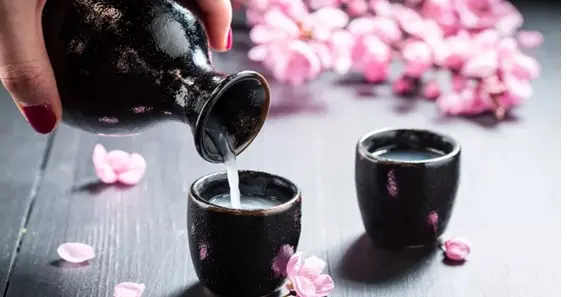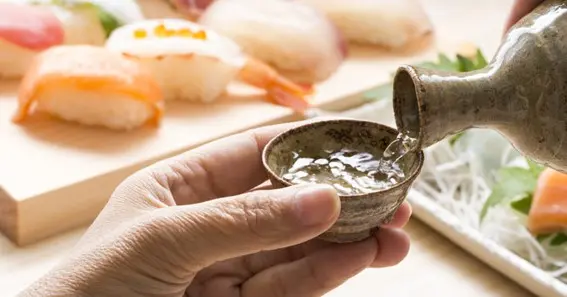What is Sake Made of? Sake is composed primarily of rice, water, koji, and yeast. Traditional Japanese drink’s sake belongs to the realm of the spirit. Sake uses shuzo-kotekimai rice. Its delicate taste is significant to Japanese culture. Rice is produced and treated differently than table rice, giving sake unique flavors and textures. Choosing and processing rice, water, koji (a mold), and yeast to make sake is a sophisticated process. This meticulous process creates a drink enjoyed worldwide and rooted in Japanese culture and craftsmanship. In this article, we discuss what is sake made of and more about it.
What Is Sake Made Of?
Sake is composed of rice, water, koji, and yeast. It’s the shuzo-kotekimai rice that makes the finished product so good. The sake rice grains are bigger and have more starch than regular rice. This is important for the brewing process. This rice uses a milling process that removes the outer layers to reach the starchy center. This amount of grinding, called the seimaibuai or rice polishing ratio, dramatically affects the sake’s taste and quality. Water is also essential in sake-making, making up 80% of the end product. The mineral composition and quality of water affect sake’s taste. For instance, Japanese water has distinct mineral concentrations and purity, which can affect flavor. Adding koji mold to rice starts saccharification. This converts rice starches into fermentable sugars.
Exploring The Ingredients And Processes Behind This Iconic Beverage

It is essential to know what is sake made of and to give yeast carbs to turn into alcohol. Yeast is the last element. It turns carbs into alcohol and carbon dioxide. The yeast types change the smell and taste of sake, making it less fruity and floral and more clean and subtle.
Sake Rice (Shuzo-Kotekimai)
But you grow shuzo-kotekimai, or sake rice, to make sake. This rice is different from the rice you eat every day. The grains are more prominent, and there is more sugar, which makes them great for fermentation. Milling rice removes nutrients, fats, and proteins, which can change how it tastes. You can read more about this process here. There are different tastes for each level of polishing. More glossy rice usually tastes better. Many people want Yamada Nishiki, Gohyakumangoku, and Omachi sake rice because it makes the sake taste and smell better.
Sake Rice (Shuzo-Kotekimai)
When making sake, water affects its appearance and taste. How complicated and mineral-rich the water is affects how, where, and how sake tastes. Mineral-rich water makes sake drier and more robust. Sake is sweeter and gentler with less mineral water. Many breweries are proud of their water. Due to their excellent water, some locations in Japan brew unique sakes.
Koji Mold
Koji mold, formally named Aspergillus oryzae, is significant for making sake. A process called saccharification changes the starches in rice into sugars that can be fermented. If you carefully grow koji on warmed rice, you get koji rice. The koji rice is mixed with more cooked rice and water to make the mash. This is where the process of raising the sugar level continues. The koji quality and the growing conditions significantly impact the sake’s taste, so this is an essential step in the brewing process.
Yeast
If you know what is sake made of, you must know when you make sake, yeast is the bacteria that turns sugar into alcohol. Each yeast type provides the end product a distinct taste and scent. Some yeasts offer fruity, floral flavors, while others add clean, unobtrusive notes. You can also change the amount of alcohol and flavor of sake by choosing the suitable yeast. Different strains do better in various temperatures and times, which can significantly change the fermentation process. It’s essential to handle these things with care.
Multiple Parallel Fermentation

For sake, multiple parallel fermentation means that fermentation and saccharification happen simultaneously. The yeast and koji work together to turn the sugars in the rice starch into alcohol. The balance between saccharification and fermentation can change the sake’s taste, smell, and general quality. Sake differs from beer or wine because it goes through multiple brewing processes simultaneously.
Milling Rate And Sake Classification
If you already know what is sake made of, you should know the grinding rate, or seimaibuai, is essential in figuring out the type and quality of sake. It tells you how much grain has been “polished off.” A seimaibuai of 60% means that 40% of the rice grain has been taken away. More polishing of the rice makes the sake more refined. The level of grinding determines the sake’s classification, with Junmai being less polished than Ginjo or Daiginjo. The milling process not only removes impurities but also changes the texture and flavor of the sake.
Conclusion
Due to its ingredients and brewing process, sake is unique among alcoholic beverages. Multiple parallel fermentations of shuzo-kotekimai rice, pure water, koji mold, and yeast produce a complex and refined drink. Explore sake’s diverse flavors and varieties to learn about Japanese sake brewers’ traditions and innovations. In above we discuss about what is sake made of and explore more about it.
FAQ
What Makes Sake Different From Other Drinking Beverages?
Multiple parallel fermentation is a unique way of making sake different from other drinks like beer and wine. It involves saccharification and fermentation happening at the same time.
What Kind Of Rice Do You Use To Make Sake?
To make sake, you need shuzo-kotekimai, a type of rice with bigger grains and more sugar, which is perfect for fermentation.
What Effect Does The Water Have On Sake?
The water quality has a significant effect on the taste of sake. Hard water makes sake taste drier, while soft water makes sake taste sweeter and smoother.
What Does The Koji Mold Do In The Making Of Sake?
To make sake, koji mold changes the rice starches into fermentable sugars, an important process called saccharification.
Why Is Seimaibuai Important?
Seimaibuai is the rate at which rice is polished when making sake. More rice grain is rubbed away when the seimaibuai is low, which makes the sake taste more refined.
Sources:










